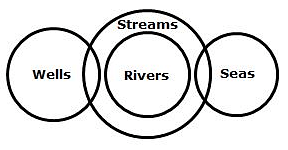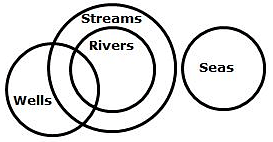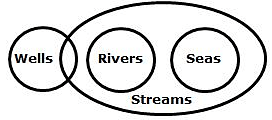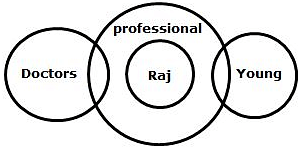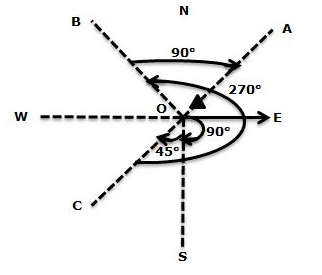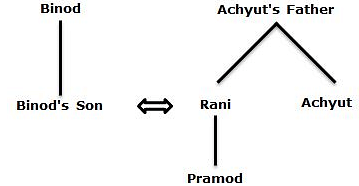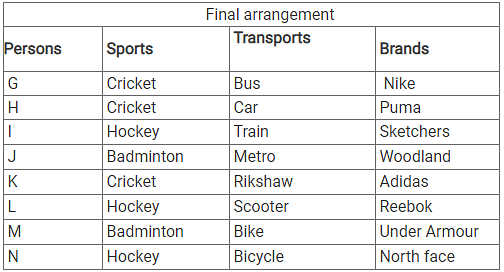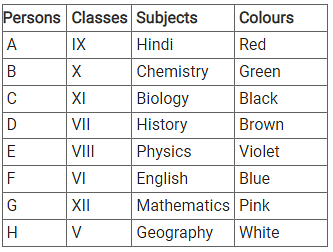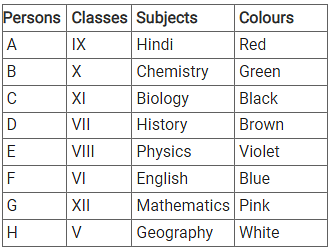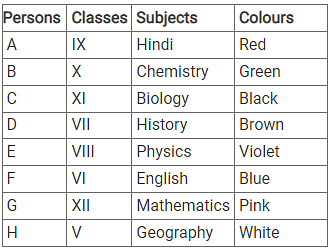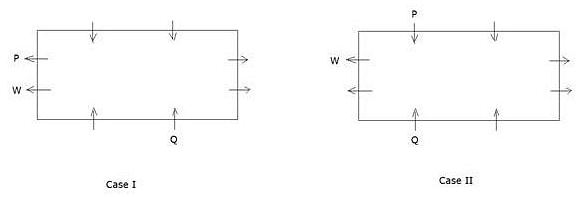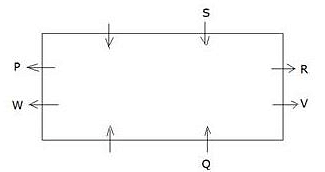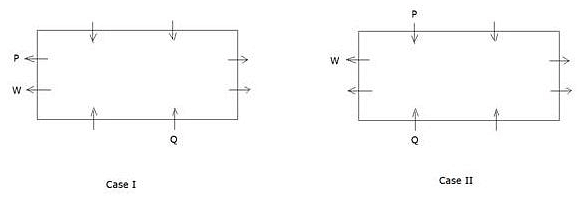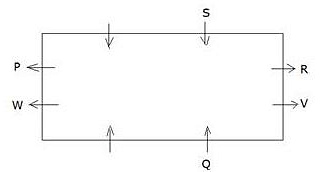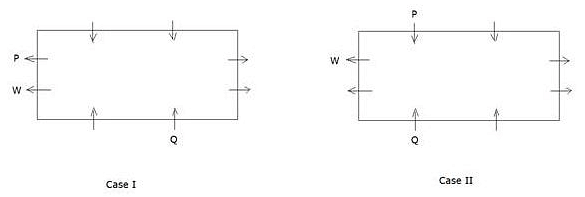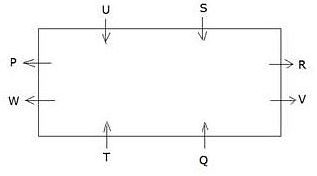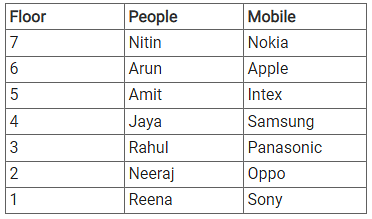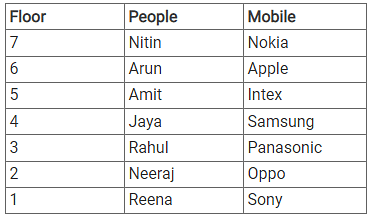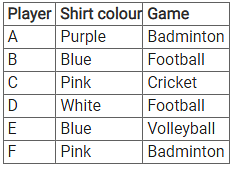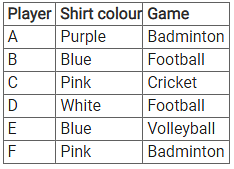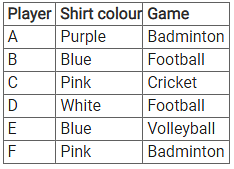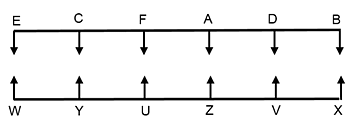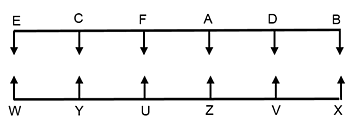MAH-CET MBA Mock Test- 8 - CAT MCQ
30 Questions MCQ Test Additional Study Material for CAT - MAH-CET MBA Mock Test- 8
“We do not want you to see our product in the newspaper, visit our shop to get a full view” -an advertisement.
Which of the following assumptions is implicit in the given statement?
A statement is followed by five assumptions marked a, b, c, d and e. Check whether these assumptions are implicit in the statement or not. Choose the appropriate one.
“Buy pure and natural honey from company X”-an advertisement in a newspaper.
Which of the following assumptions is implicit in the given statement?
| 1 Crore+ students have signed up on EduRev. Have you? Download the App |
The question given below consists of a statement, followed by two arguments I and II. You have to decide which of the arguments is a ‘strong’ argument and which is a ‘weak argument.
Statement:
Should there be uniforms for students in the colleges in India as in the schools?
Arguments:
I. Yes, this will improve the ambience of the colleges as all the students will be decently dressed.
II. No, the college students should not be regimented and they should be left to choose their clothes for coming to the college.
Direction: In the following questions, the symbols #, %,@, $ and ©are used with the following meanings illustrated.
‘P # Q’ means ‘P is not smaller than Q’
‘P % Q’ means’ P is not greater than Q’.
‘P @ Q’ means ‘P is neither smaller than nor equal to Q’.
‘P $ Q’ means ‘P is neither greater than nor equal to Q’.
‘P © Q’ means ‘P is neither smaller than nor greater than Q’.
In each of the following questions assuming the given statements to be true, find out which of the two conclusions I and II given below them is/are definitely true.
Statement:
H © W, W % R, R @ F
Conclusions:
I. R©H
II. R @ H
Direction: In the following questions, the symbols #, %,@, $ and ©are used with the following meanings illustrated.
‘P # Q’ means ‘P is not smaller than Q’
‘P % Q’ means’ P is not greater than Q’.
‘P @ Q’ means ‘P is neither smaller than nor equal to Q’.
‘P $ Q’ means ‘P is neither greater than nor equal to Q’.
‘P © Q’ means ‘P is neither smaller than nor greater than Q’.
In each of the following questions assuming the given statements to be true, find out which of the two conclusions I and II given below them is/are definitely true.
Statement:
R % N, N # F, F @ B
Conclusions:
I. F©R
II. B$N
Direction: In the following questions, the symbols #, %,@, $ and ©are used with the following meanings illustrated.
‘P # Q’ means ‘P is not smaller than Q’
‘P % Q’ means’ P is not greater than Q’.
‘P @ Q’ means ‘P is neither smaller than nor equal to Q’.
‘P $ Q’ means ‘P is neither greater than nor equal to Q’.
‘P © Q’ means ‘P is neither smaller than nor greater than Q’.
In each of the following questions assuming the given statements to be true, find out which of the two conclusions I and II given below them is/are definitely true.
Statement:
R#T, T©M, M @ D
Conclusions:
I. D$T
II. R#M
Direction: In each question below are given two statements followed by two conclusions numbered I and II. You have to take the two given statements to be true even if they seem to be at variance with commonly known facts. Read the conclusions and then decide which of the given conclusions logically follows from the given statements disregarding commonly known facts.
Statements:
All rivers are streams. Some streams are wells. No well is the sea.
Conclusion:
I. Some rivers are wells.
II. Some seas are not stream.
Direction: In each question below are given two statements followed by two conclusions numbered I and II. You have to take the two given statements to be true even if they seem to be at variance with commonly known facts. Read the conclusions and then decide which of the given conclusions logically follows from the given statements disregarding commonly known facts.
Statements:
Some doctors are professional. Raj is a professional. Raj is not young.
Conclusion:
I. Some doctors are young.
II. Some young doctors are not professional.
A man is facing east. He turns 90° clockwise and then again 45° in the same direction. Finally he turns 270° anticlockwise and 90° clockwise. What is the direction which he is facing now?
Binod’s son is the son-in-law of Achuyut’s father. Rani is Achyut’s only sister. Binod has only one grandson Pramod. How is Pramod related to Rani?
Direction: Study the following information carefully and answer the given questions:
The following is an illustration of input and rearrangement. (All the numbers are two digits numbers)
INPUT: 81 cheerful 23 machine 36 42 51 sweet reward
Step 1: 23 81 machine 36 42 51 sweet reward cheerful
Step 2: 23 81 machine 36 42 51 reward cheerful sweet
Step 3: 23 81 36 42 51 reward cheerful sweet machine
Step 4: 23 81 36 51 42 cheerful sweet machine reward
Step 4 is the last step of the given arrangement
Study the given arrangement and arrange the given input accordingly.
Input: video divine 29 61 nearly annual arrange 72 37 garden 12 seven 51 98.
Which of the following element be fifth from the left end in step 3?
Direction: Study the following information carefully and answer the given questions:
The following is an illustration of input and rearrangement. (All the numbers are two digits numbers)
INPUT: 81 cheerful 23 machine 36 42 51 sweet reward
Step 1: 23 81 machine 36 42 51 sweet reward cheerful
Step 2: 23 81 machine 36 42 51 reward cheerful sweet
Step 3: 23 81 36 42 51 reward cheerful sweet machine
Step 4: 23 81 36 51 42 cheerful sweet machine reward
Step 4 is the last step of the given arrangement
Study the given arrangement and arrange the given input accordingly.
Input: video divine 29 61 nearly annual arrange 72 37 garden 12 seven 51 98.
Which of the following elements will be to the immediate right of the third largest number in the last step?
Direction: Study the following information carefully and answer the given questions:
The following is an illustration of input and rearrangement. (All the numbers are two digits numbers)
INPUT: 81 cheerful 23 machine 36 42 51 sweet reward
Step 1: 23 81 machine 36 42 51 sweet reward cheerful
Step 2: 23 81 machine 36 42 51 reward cheerful sweet
Step 3: 23 81 36 42 51 reward cheerful sweet machine
Step 4: 23 81 36 51 42 cheerful sweet machine reward
Step 4 is the last step of the given arrangement
Study the given arrangement and arrange the given input accordingly.
Input: video divine 29 61 nearly annual arrange 72 37 garden 12 seven 51 98.
How many steps will be required to complete the given arrangement based on the given input?
Direction: Study the following information carefully and answer the question given below:
Eight persons i.e. G, H, I, J, K, L, M and N are members of a sports club. They play three different Sports i.e. Cricket, Badminton and Hockey. Not more than three and not less than two persons like the same sport. They all are using a different mode of transports i.e. Metro, Bus, Car, Train, Bike, Bicycle, Scooter and Rickshaw. They all like different sports brands i.e. Puma, Adidas, Reebok, Nike, Sketchers, Woodland, North Face and Under Armour. All the information is not necessarily in the same order.
M uses a Bike and plays only with J but not Cricket. N likes North face. K plays Cricket with H who uses Car. I like Sketchers. The one who plays Hockey likes Reebok and uses Scooter. The one who likes the Nike brand uses Bus. K and J do not like Nike. N does not play Cricket. N does not go by Metro and Train. J does not go by Train and Bicycle. The one who goes by Rickshaw likes Adidas. L and J do not go by Rickshaw. The one who likes Puma plays Cricket. L does not like Cricket. The one who goes by Metro likes Woodland. G does not play Hockey. The one who goes by Train plays Hockey.
Four of the following five are alike in a certain way and hence form a group. Find the one which does not belong to that group?
Direction: Study the following information carefully and answer the question given below:
Eight persons i.e. G, H, I, J, K, L, M and N are members of a sports club. They play three different Sports i.e. Cricket, Badminton and Hockey. Not more than three and not less than two persons like the same sport. They all are using a different mode of transports i.e. Metro, Bus, Car, Train, Bike, Bicycle, Scooter and Rickshaw. They all like different sports brands i.e. Puma, Adidas, Reebok, Nike, Sketchers, Woodland, North Face and Under Armour. All the information is not necessarily in the same order.
M uses a Bike and plays only with J but not Cricket. N likes North face. K plays Cricket with H who uses Car. I like Sketchers. The one who plays Hockey likes Reebok and uses Scooter. The one who likes the Nike brand uses Bus. K and J do not like Nike. N does not play Cricket. N does not go by Metro and Train. J does not go by Train and Bicycle. The one who goes by Rickshaw likes Adidas. L and J do not go by Rickshaw. The one who likes Puma plays Cricket. L does not like Cricket. The one who goes by Metro likes Woodland. G does not play Hockey. The one who goes by Train plays Hockey.
Which of the following statements is/are not true?
Direction: Study the following information carefully and answer the question given below:
There are eight students i.e. A, B, C, D, E, F, G and H are studying in different classes i.e. V, VI, VII, VIII, IX, X, XI and XII of a school. They all like different subjects i.e. Biology, Physics, Mathematics, Chemistry, History, Geography, English and Hindi and different colours i.e. Red, Blue, White, Black, Green, Pink, Violet and Brown. All the information is not necessarily in the same order.
E likes Physics and studies in the fourth-lowest class. The one who likes Pink is senior to the one who likes Violet. There is a difference of three classes between E and C who likes Black colour. A likes Red colour and Hindi. A is junior to B who likes Green colour. C is just a junior to G who likes Mathematics. B likes Chemistry but doesn’t like pink. F likes Blue colour but doesn’t study in VII class. Four students are junior to G but senior to D. There is a difference of two classes between D and H. The one who is just senior to H likes English. The one who likes History also likes Brown. The one who likes Biology doesn’t like the white colour. The one who studies in V class likes White colour.
Who amongst the following students likes Violet colour?
Direction: Study the following information carefully and answer the question given below:
There are eight students i.e. A, B, C, D, E, F, G and H are studying in different classes i.e. V, VI, VII, VIII, IX, X, XI and XII of a school. They all like different subjects i.e. Biology, Physics, Mathematics, Chemistry, History, Geography, English and Hindi and different colours i.e. Red, Blue, White, Black, Green, Pink, Violet and Brown. All the information is not necessarily in the same order.
E likes Physics and studies in the fourth-lowest class. The one who likes Pink is senior to the one who likes Violet. There is a difference of three classes between E and C who likes Black colour. A likes Red colour and Hindi. A is junior to B who likes Green colour. C is just a junior to G who likes Mathematics. B likes Chemistry but doesn’t like pink. F likes Blue colour but doesn’t study in VII class. Four students are junior to G but senior to D. There is a difference of two classes between D and H. The one who is just senior to H likes English. The one who likes History also likes Brown. The one who likes Biology doesn’t like the white colour. The one who studies in V class likes White colour.
If the classes of the students who like English and Geography are interchanged by the teachers according to their class performance then who amongst the following is two class senior to H?
Direction: Study the following information carefully and answer the question given below:
There are eight students i.e. A, B, C, D, E, F, G and H are studying in different classes i.e. V, VI, VII, VIII, IX, X, XI and XII of a school. They all like different subjects i.e. Biology, Physics, Mathematics, Chemistry, History, Geography, English and Hindi and different colours i.e. Red, Blue, White, Black, Green, Pink, Violet and Brown. All the information is not necessarily in the same order.
E likes Physics and studies in the fourth-lowest class. The one who likes Pink is senior to the one who likes Violet. There is a difference of three classes between E and C who likes Black colour. A likes Red colour and Hindi. A is junior to B who likes Green colour. C is just a junior to G who likes Mathematics. B likes Chemistry but doesn’t like pink. F likes Blue colour but doesn’t study in VII class. Four students are junior to G but senior to D. There is a difference of two classes between D and H. The one who is just senior to H likes English. The one who likes History also likes Brown. The one who likes Biology doesn’t like the white colour. The one who studies in V class likes White colour.
Four of the following five are alike in a certain way and hence form a group. Which is the one that doesn’t belong to that group?
Direction: Eight people - P, Q, R, S, T, U, V and W are standing in a rectangular park such that at each side of the rectangular park, two persons are standing. The ones who are standing at the shorter sides are facing outside the park while the ones at the longer side are facing inside the park.
P is standing to the immediate right of W, who stands at a shorter side. R is standing second to the right of Q, who is second to the left of W. Q is standing such that it faces S. V doesn't face inside the park. U is not a neighbour of Q.
Who is standing fourth to the right of W?
Direction: Eight people - P, Q, R, S, T, U, V and W are standing in a rectangular park such that at each side of the rectangular park, two persons are standing. The ones who are standing at the shorter sides are facing outside the park while the ones at the longer side are facing inside the park.
P is standing to the immediate right of W, who stands at a shorter side. R is standing second to the right of Q, who is second to the left of W. Q is standing such that it faces S. V doesn't face inside the park. U is not a neighbour of Q.
Who is standing facing away from W. (in the same line of sight)?
Direction: Eight people - P, Q, R, S, T, U, V and W are standing in a rectangular park such that at each side of the rectangular park, two persons are standing. The ones who are standing at the shorter sides are facing outside the park while the ones at the longer side are facing inside the park.
P is standing to the immediate right of W, who stands at a shorter side. R is standing second to the right of Q, who is second to the left of W. Q is standing such that it faces S. V doesn't face inside the park. U is not a neighbour of Q.
How many persons are standing between U and V, if seen from the right of U?
Direction: Study the following information and answer the question.
Seven people Jaya, Arun, Reena, Nitin, Neeraj, Rahul, and Amit live on separate floors of a 7-floor building. The ground floor is numbered 1, the first floor is numbered 2, and so on until the topmost floor is numbered 7. Each one of these likes different companies mobile, viz Sony, Samsung, Apple, Nokia, Panasonic, Oppo, and Intex but not necessarily in the same order.
Only three people live above the floor on which Jaya lives. Only one person lives between Jaya and the one who likes Oppo. Rahul lives immediately below the one who likes Samsung. The one who likes Samsung lives on an even-numbered floor. Only three people live between the ones who like Oppo and Apple. Neeraj lives immediately above Reena. Neeraj does not like Apple. Only two people live between Arun and the one who likes Panasonic. The one who likes Panasonic lives below the floor on which Arun. The one who likes Sony does not live immediately above or immediately below Arun. Nitin does not live immediately above or immediately below Jaya. Amit does not like Nokia.
Who among the following lives on floor number 3?
Direction: Study the following information and answer the question.
Seven people Jaya, Arun, Reena, Nitin, Neeraj, Rahul, and Amit live on separate floors of a 7-floor building. The ground floor is numbered 1, the first floor is numbered 2, and so on until the topmost floor is numbered 7. Each one of these likes different companies mobile, viz Sony, Samsung, Apple, Nokia, Panasonic, Oppo, and Intex but not necessarily in the same order.
Only three people live above the floor on which Jaya lives. Only one person lives between Jaya and the one who likes Oppo. Rahul lives immediately below the one who likes Samsung. The one who likes Samsung lives on an even-numbered floor. Only three people live between the ones who like Oppo and Apple. Neeraj lives immediately above Reena. Neeraj does not like Apple. Only two people live between Arun and the one who likes Panasonic. The one who likes Panasonic lives below the floor on which Arun. The one who likes Sony does not live immediately above or immediately below Arun. Nitin does not live immediately above or immediately below Jaya. Amit does not like Nokia.
Nitin likes which of the following mobile?
Direction: Study the following arrangement carefully and answer the questions given below.
Six players A, B, C, D, E, and F play four different games viz. Badminton, Football, Cricket, Volleyball and wear shirts of four different colours i.e. White, Pink, Blue, and Purple shirts.
C wears either a White or Pink shirt. E does not play Cricket and the person who plays Volleyball does not wear a white shirt; A neither wears a Pink shirt nor plays Volleyball. Both of the Football players wear shirts of different colors but do not wear Purple shirts. F plays Badminton; Badminton player does not wear White shirt, two players wear Blue shirts and one wears Purple. One player is in Cricket and wears a Pink, D wears a White shirt and a Badminton player does not wear a blue shirt. E is in Volleyball and wears Blue while A wears a Purple shirt. Not more than two players are in the same game and wear the same shirt.
Which of the following shirts is worn by two players?
Direction: Study the following arrangement carefully and answer the questions given below.
Six players A, B, C, D, E, and F play four different games viz. Badminton, Football, Cricket, Volleyball and wear shirts of four different colours i.e. White, Pink, Blue, and Purple shirts.
C wears either a White or Pink shirt. E does not play Cricket and the person who plays Volleyball does not wear a white shirt; A neither wears a Pink shirt nor plays Volleyball. Both of the Football players wear shirts of different colors but do not wear Purple shirts. F plays Badminton; Badminton player does not wear White shirt, two players wear Blue shirts and one wears Purple. One player is in Cricket and wears a Pink, D wears a White shirt and a Badminton player does not wear a blue shirt. E is in Volleyball and wears Blue while A wears a Purple shirt. Not more than two players are in the same game and wear the same shirt.
Which of the games is played and the shirt is worn by B?
Direction: Study the following arrangement carefully and answer the questions given below.
Six players A, B, C, D, E, and F play four different games viz. Badminton, Football, Cricket, Volleyball and wear shirts of four different colours i.e. White, Pink, Blue, and Purple shirts.
C wears either a White or Pink shirt. E does not play Cricket and the person who plays Volleyball does not wear a white shirt; A neither wears a Pink shirt nor plays Volleyball. Both of the Football players wear shirts of different colours but do not wear Purple shirts. F plays Badminton; Badminton player does not wear White shirt, two players wear Blue shirts and one wears Purple. One player is in Cricket and wears a Pink, D wears a White shirt and a Badminton player does not wear a blue shirt. E is in Volleyball and wears Blue while A wears a Purple shirt. Not more than two players are in the same game and wear the same shirt.
Which of the games is played by the two players except for Football?
Direction: Study the following information carefully and answer the given questions.
Twelve persons A, B, C, D, E, F, U, V, W, X, Y, and Z are sitting in two parallel rows. A, B, C, D, E, and F are sitting in row-1 facing south direction, and U, V, W, X, Y, and Z are sitting in row-2 facing north direction in such a way that each person sitting in row-1 faces the person sitting in row-2. E, who sits at one of the extreme ends of the row sits third to the right of the one who faces Z. X faces the one who sits second to the left A. V faces D. B, who is sitting at the extreme left end, sits second to the left of A. C faces the one who is an immediate neighbour of U. Only one person sits between U and W who is sitting at the extreme left end of the row.
Who among the following faces Z?
Direction: Study the following information carefully and answer the given questions.
Twelve persons A, B, C, D, E, F, U, V, W, X, Y, and Z are sitting in two parallel rows. A, B, C, D, E, and F are sitting in row-1 facing south direction, and U, V, W, X, Y, and Z are sitting in row-2 facing north direction in such a way that each person sitting in row-1 faces the person sitting in row-2. E, who sits at one of the extreme ends of the row sits third to the right of the one who faces Z. X faces the one who sits second to the left A. V faces D. B, who is sitting at the extreme left end, sits second to the left of A. C faces the one who is an immediate neighbour of U. Only one person sits between U and W who is sitting at the extreme left end of the row.
Who among the following sits third to the right of the one, who is facing the one, who is second to the left of E?
Directions: In each of the questions below, a short passage is given outlining a point. Read the passage and answer the questions that follow.
Jatin: Developing countries like ours need to invest in education and job creation. They need to address the lack of opportunities in order to improve their economy and reduce migration. Our country produces so many engineering and MBA graduates but only a small percentage of them find jobs. It should therefore be no surprise that many migrate overseas for opportunities.
Lalit: Lack of opportunities in one's own country is not the only reason why educated persons migrate. Our country has a conservative culture which many of the educated persons feel alienated from, so they seek other countries whose societies are more open and free-thinking than ours.
It can be understood from the extract that Lalit has misunderstood Jatin's argument to mean which of the following?
In the given series, if all the alphabets are replaced by their corresponding position in the alphabet series, if all the prime numbers are replaced by the next smallest composite number, and all the composite numbers are replaced by the previous largest prime number and then all the even numbers are removed in the series, then which of the following will be sixth from the right end of the new arrangement?
A 5 3 8 R 55 65 T 76 45 21 2 W 54 32 11 E 89 71 R 4 5 Y 31 U I 6 O 17 P
|
5 videos|378 docs|164 tests
|
|
5 videos|378 docs|164 tests
|


